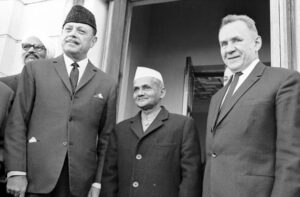Indo- Pak and the Soviet rush at Tashkent


Today, we are celebrating the 57th anniversary of the Tashkent Declaration, which was aimed to put a stop to hostilities between India and Pakistan. After Soviet diplomacy mediated the signing of the proclamation, Alexei Kosygin, the head of the Council of Ministers, personally oversaw the process. Though the peace between two nations did not stay for long, this document is regarded as one of the best mediation instances in world affairs.


Both the United States and the Soviet Union were concerned about this because they thought China would intervene in the war. During the time of the hostile relations between the Soviet Union and China, the American authorities did not have any particular influence over the Chinese leadership. After the pertinent resolution was enacted by the Security Council in September 1965, both nations agreed to abide by the cease-fire, which was imposed by the Great Powers using their influence in the UN Security Council.
But the cease-fire could have started anytime, this sensed the need for a more formal agreement, the USSR Council of Ministers Chairman Kosygin personally offered to serve as mediator on behalf of the Soviet Union. As per the memoirs of contemporaries, Kosygin had the trust of both sides. He was instrumental in resolving the Indo-Pakistan conflict.
The fact that Pakistani President Muhammad Ayub Khan was keen to strengthen ties with the Soviet Union in addition to steering his nation in accordance with US policy had a significant role as well. But the primary thing that helped the negotiation process start off well was that the Americans and Soviets shared the same level of desire in ending the fight.
The Soviet magazine Ogonyok stated,
“Peace and cooperation—that is what the historic Tashkent Declaration means,
and the world has heard of it.”
The Indian Prime Minister’s death and its circumstances remain a mystery. There were suspicions that the cooks had poisoned him, although these were eventually disproved. In the West, people were more inclined to blame the USSR for Shastri’s demise.
The Tashkent Declaration was regarded as a significant achievement of Soviet diplomacy in the settlement of international disputes, albeit this tragic incident. In India, the Declaration was not well received. The Communist Party of India and the Indian National Congress Party supported the pact, but opposition groups claimed the peace treaty had demoralized the nation.
According to Peter Topychkanov, the Tashkent Declaration:
“Did not lead to the resolution of the crisis.”
Recent Posts
સાંસદોને પગાર વધારાની જરૂર લાગે છે!?
24 ટકાના વધારા પછી લોકોના મનમાં એક જ સવાલ,સાંસદો 5 વર્ષમાં કેવી રીતે કરોડો કમાતા…
આજે વિશ્વ વન દિવસ..જાણો કેમ મહત્વનો છે આજનો દિવસ
દર મીનીટે 36 ફુટબોલ મેદાન જેટલા કુદરતી વનોનો નાશ થઇ રહ્યો છે. ભારતમાં 33%ને બદલે…
વિશ્વ કવિતા દિવસ 2025: કવિતાનું મહત્વ અને સમાજમાં તેની ભૂમિકા
આજે વિશ્વ કવિતા દિવસ છે ત્યારે પ્રેમ હુંફ અને લાગણીઓ સાથે કલ્પનાની દુનિયા ઉમેરાય અને…
ગુજરાત પોલીસનું ઓપરેશન પતાલલોક: ગુંડાઓ સામે કડક કાર્યવાહી
પોલીસનું ઓપરેશન પતાલલોક! ડીજીપીના આદેશ છુટતા બિલમાં સંતાયેલાને બહાર લાવી કાયદાનો ડંડો વીંઝાશે!ગુંડારાજ વધતા પોલીસ…
મસાનમાં ‘ભસ્મ હોળી’ કેમ રમાય છે જાણો?
આ અનોખી પરંપરા અનાદિ કાળથી ચાલતી હોવાનો દાવો.મસાન હોળી વારાણસીના મણિકર્ણિકા ઘાટ પર મનાવવામાં આવી.…
હજુ પણ ગુજરાતમાં જીવે છે અંધશ્રદ્ધા!
અંધશ્રદ્ધાના અંત માટે સ્વૈચ્છિક સંગઠનો અને સરકાર દ્વારા અભિયાનો ચલાવવામાં આવી રહ્યા છે. છતાં સમાજમાંથી…


